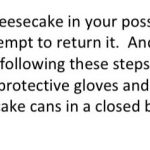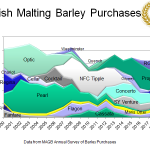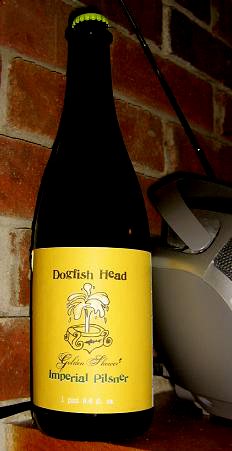 I almost took this week off. It’s been a very busy stretch at work. It’s good busy, mind you. Takes the mind off the pandemic, the near death experience suffered by American democracy and winter and… and… and… Other than that, I did see both the nearest and seventh farthest planets from the Sun last weekend. That was cool. And, see, I noticed the winter brown goldfinches at the feeder just starting to show their yellow feathers at their shoulders. Spring is coming. Oh, and I had a beer or some beer or something at some point. This is still a beer blog, right?
I almost took this week off. It’s been a very busy stretch at work. It’s good busy, mind you. Takes the mind off the pandemic, the near death experience suffered by American democracy and winter and… and… and… Other than that, I did see both the nearest and seventh farthest planets from the Sun last weekend. That was cool. And, see, I noticed the winter brown goldfinches at the feeder just starting to show their yellow feathers at their shoulders. Spring is coming. Oh, and I had a beer or some beer or something at some point. This is still a beer blog, right?
Hmm… what’s in the news? Horrible breweries apparently. First, the end times seem to have struck once again in the semi-beer fruity gak. You a betting reader? Seriously, when is it going to die off? The exploding gak. Jeff started it. And the we end up here. Really. Just look to the right at the warning one horrible brewery had to issue and consider how horrible the warning issued by the horrible brewery actually is. Actually, I know nothing about the horrible brewery except it is happy, first, putting out a horrible fruit gak beer and, then, a horrible warning about the horrible fruit gak beer. Hide the exploding can in your garbage, they say. Hide the exploding can in your garbage? That’s the advice? Did they check with the local solid waste dept? So they must be horrible. Right? Right. I hope they are not but they might well be. Watch your step. You, too.
If that was not enough,* Vinepair started the ball rolling with the story of another horrible idea, the $90 six pack. It’s a dumb idea which has nothing to do with the beer and everything to do with the $90 despite the spin:
After talking to Gislason, however, I don’t think he deserves derision for Hanabi Lager. Though he’s got grand ambitions, and a funny way of revealing them, his ego is in check. You will probably roll your eyes a few more times as you read this story, sure, but who knows? Gislason might very well be taking lager to a place it’s never been before. “The vast majority of beer consumed in the world is lager, albeit an ‘industrial-commodity’ version that’s relatively simple and homogeneous in flavor,” says Gislason. “Recognizing that high-quality lager brewing was underrepresented in the craft brewing world, that became our brewing R&D focus about 10 years ago.”
Sucker juice. A sad tale based on a false premise. Jeff perhaps was unnecessarily detailed in his criticism, giving the discussion a little too much oxygen. It’s not about disrespect as much as not giving a shit. These things arise from time to time and either die off or end up in the business acquisition they were actually initially set up to serve. Best response? This:
Fuck these guys, we do the same thing for $12 a four pack.
Speaking of horrible brewers, the big story of the week would be the situation at Boulevard Brewing, which was first described in a Reddit post:
I left Boulevard Brewing Company in March 2020 because of harassment I received because I was pregnant. My boss stood me and another female employee up in the lab, in front of another coworker, and demanded to know if we were pregnant. When we refused to answer, he told the other woman “the only way you could be pregnant is by your cat”, then continued to ask me. I reported this to HR, but it started a cycle of reporting his behavior to HR and then being punished (by him) for going to HR.
Nutzo. If denigrating and potentially illegal employment standards could be wrapped up in the word “nutzo”… which it might or might not. It’s sorta sweet – in no way that makes any sense on this planet – that the brewery issued a statement that says it was all fine… a joke maybe… but not real… look over here… shadow puppets… AND then, on Wednesday, they repented or at least reflected and started living in reality. THEN, late Wednesday, folk identifying as employees posted an alternate version of reality, of multiple executive firings. Wow. Need to keep an eye on this one.
So much for beer people are good people. Some are. Some aren’t. Speaking of which, beer people writing about other beer people is usually dull as dishwater… or worse, less interesting than exploding fruity gak or a $90 six pack or sexist piggy stuff. But in this case the bio bit on Chalonda White, aka Afro Beer Chick, is good. Very good. I should work one like that, too, but on me. If I was that good. But I am not as interesting. And not committed to important things like Chalonda is. I could learn a thing or two. Grow up a bit.
Enough!. Let’s look elsewhere. Brexit’s effect on the UK wine trade is petty shocking as described by one wine merchant:
I now hope, if the wind is blowing in the right direction, to start seeing stock from early February. My orders with producers were placed as far back as December. So from what was a 7-10 days turn around has become a 5-6 week turn around. Another of those Brexit dividends. 14/22…
Just last week, we discussed* the effects of Brexit on the UK import market. This seems to indicate it is going to be ugly.
Note: it’s never a good idea to use social media to self doom scroll after you get an article published. Blaming headline writers, the readers… anyone with a different view is a bit weird. If it isn’t explained in the story… is it a good story?
One of Canada’s beer blogs that likes to pretend it isn’t a blog has posted a good piece with four people involved in the beer trade talking about the pivot and the way forward:
At Matron we’ve learned to adapt to the rapidly changing market: we’ve leaned into online sales and home delivery. In fact, we predict that to make up for the shortfall in bar and restaurant sales, breweries will need to sell up to half of their beer online this winter to survive. On the flipside, you, the craft beer drinker, have gained incredible access to the majority of Ontario breweries, whether it be shopping directly from the brewery’s website, or supporting one of the many independent bottle shops that have sprung up.
I am rooting for them all. Matron is one of my near neighbours… in the Canadian sense, an hour’s drive away.
And Matt C wrote about Czech v. German in Ferment 52 and has found a number of solid witnesses to give testimony as to their preference. I approve of the following point most heartily:
But one bone I must pick is with those who replied to my poll by stating they don’t like Czech beer because of the diacetyl (an off flavour that makes your beer taste like butter.) And I understand Czech beers often have a rich, butterscotch flavour, but it’s not like the hot buttered popcorn character that makes you want to tip a pint of naff cask down the drain. “People who say things like that are the type who talk without knowing what they’re talking about,” Evan says, bluntly. “But yeah, there is diacetyl in Czech beer sometimes. There’s diacetyl in German beer sometimes, too.”
The diacetyl police are amongst the most tedious of beer fans. As far as I am concerned it all comes from (i) nutritionalism*** and (ii) need-to-take-a-stand-ism and (iii) the unfortunate proliferation of off-flavour seminars rather than on-flavour seminars.
There. Unfortunately, more seriously nasty stuff going on than good. But some good and we have the eternal glow of the deep and abiding hope for more good. To continue your quest for actually good reading check out the weekly updates from Boak and Bailey, back now mostly every Saturday, plus more at the OCBG Podcast on Tuesday and sometimes on a Friday posts at The Fizz as well. We have a new entry from the DaftAboutCraft podcast. And sign up for Katie’s weekly newsletter, The Gulp, too. Plus the venerable Full Pint podcast. And Fermentation Radio with Emma Inch. There’s the AfroBeerChick podcast as well! And also look at Brewsround and Cabin Fever. And Ben has his own podcast, Beer and Badword. And remember BeerEdge, too.
*Which is good for me because, in case you haven’t noticed I like to write a weekly post about all the things I read about so that you can read that in addition to all the things I read about.
**You did have a roundtable discussion by Zoom meeting afterwards, right?
***See Michael Pollen, yes, but see also a sort of fraidy-cat approach to things and the deference to the people who, utterly hypocritically, ended up giving you strawberry milkshake sour fruit candy beer crap. Have a Yorkshire bitter from an actual open square fermenter. Enjoy the slight buttery goodness.









 It’s not often that I get to headline the weekly update with something so.. so… unbeery – but is beer ever really that much removed from politics? Consider this photo to the right that
It’s not often that I get to headline the weekly update with something so.. so… unbeery – but is beer ever really that much removed from politics? Consider this photo to the right that  Barry in Germany posted an afternoon’s worth of photos of
Barry in Germany posted an afternoon’s worth of photos of 





